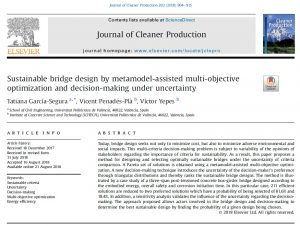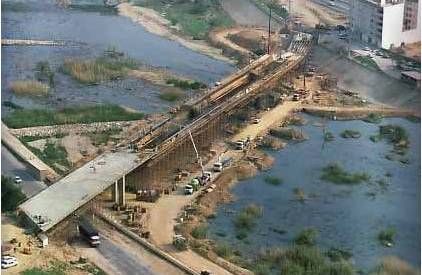 Nos acaban de publicar en la revista de Elsevier del primer decil, Journal of Cleaner Production, un artículo donde se propone una nueva metodología en la toma de decisiones del diseño óptimo de un puente bajo criterios de sostenibilidad y bajo incertidumbre. Este artículo forma parte de nuestra línea de investigación BRIDLIFE en la que se pretenden optimizar estructuras atendiendo no sólo a su coste, sino al impacto ambiental y social que generan a lo largo de su ciclo de vida.
Nos acaban de publicar en la revista de Elsevier del primer decil, Journal of Cleaner Production, un artículo donde se propone una nueva metodología en la toma de decisiones del diseño óptimo de un puente bajo criterios de sostenibilidad y bajo incertidumbre. Este artículo forma parte de nuestra línea de investigación BRIDLIFE en la que se pretenden optimizar estructuras atendiendo no sólo a su coste, sino al impacto ambiental y social que generan a lo largo de su ciclo de vida.
Abstract:
Today, bridge design seeks not only to minimize cost but also to minimize adverse environmental and social impacts. This multi-criteria decision-making problem is subject to variability of stakeholders’ opinions regarding the importance of criteria for sustainability. As a result, this paper proposes a method for designing and selecting optimally sustainable bridges under the uncertainty of criteria comparison. A Pareto set of solutions is obtained using a metamodel-assisted multi-objective optimization. A new decision-making technique introduces the uncertainty of the decision-makers preference through triangular distributions and thereby ranks the sustainable bridge designs. The method is illustrated by a case study of a three-span post-tensioned concrete box-girder bridge designed according to the embodied energy, overall safety, and corrosion initiation time. In this case, 211 efficient solutions are reduced to two preferred solutions with a probability of being selected of 81.6% and 18.4%. In addition, a sensitivity analysis validates the influence of the uncertainty regarding the decision-making. The approach proposed allows actors involved in the bridge design and decision-making to determine the best sustainable design by finding the probability of a given design being chosen.
Keywords:
- Sustainable criteria
- Uncertainty
- Decision-making
- Multi-objective optimization
- Energy efficiency
Reference:
GARCÍA-SEGURA, T.; PENADÉS-PLÀ, V.; YEPES, V. (2018). Sustainable bridge design by metamodel-assisted multi-objective optimization and decision-making under uncertainty. Journal of Cleaner Production, 202:904-915. https://doi.org/10.1016/j.jclepro.2018.08.177






